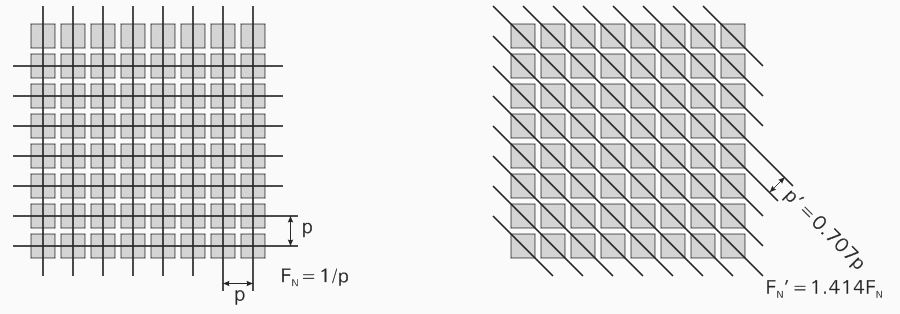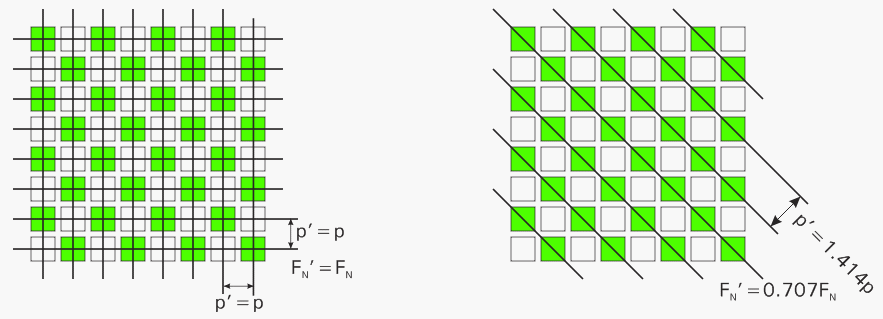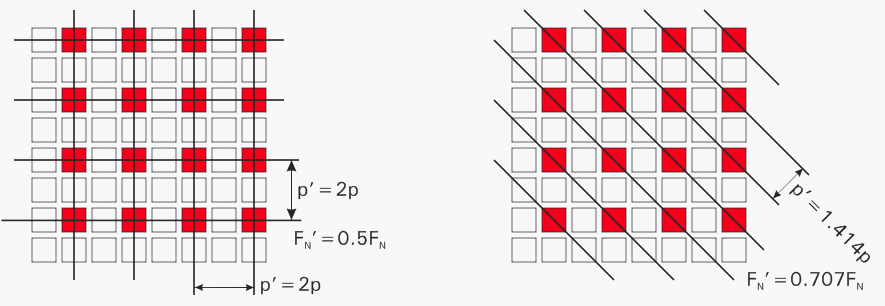Doug Kerr
Well-known member
We sometimes hear it said (in fact, I said it just this morning) that:
How can this be? The G layer has only half as many sensels as the monochrome sensor.
The key to this conundrum is that the statement above is true in part but not completely stated.
The issue is that the Nyquist frequency of a sensor (and thus its potential resolution) is not the same for detail along all axes.
A more complete statement would be:
To help us follow that notion, this figure represents a monochrome sensor (conventional orientation) with pixel pitch p.

Monochrome array
In the left-hand panel we consider detail running along the horizontal or vertical axes. For the horizontal detail, the pitch of the pixels is that indicated by the vertical lines. They are at a spacing p, and so for the horizontal detail, the Nyquist frequency, FN, is 1/(2p) (and the resolution might be about 0.75 times that).
For the vertical detail, the pitch of the pixels is that indicated by the horizontal lines. They are at a spacing p, and so for the vertical detail, the Nyquist frequency, FN, is again 1/(2p) (and the resolution might be about 0.75 times that).
In the right-hand panel we consider detail running along an axis running upward and to the right at an angle of 45° to the horizontal. (The situation is comparable for the opposite diagonal axis, but I don't show that to avoid cluttering the figure.) For that detail, the pitch of the pixels is that indicated by the diagonal lines. They are at a spacing 0.707p, and so for the that diagonal detail, the Nyquist frequency, FN', is is 1.414 times the "mopnochrome" Nyquist frequency, FN, (and the resolution might be about 0.75 times that).
Wow! We have greater resolution potential for detail running along diagonal axes than for detail running along a vertical or horizontal axis. Can we take advantage of that? Sure. By shooting objects where the important detail runs along diagonal axes. Like what? A brick wall shot with the camera rolled at a 45° angle.
But back to our story. This figure represents the G layer of a Bayer CFA sensor (conventional orientation) with overall pixel pitch p.

Bayer CFA array - G layer
As before, in the left-hand panel we consider detail running along the horizontal or vertical axes. For the horizontal detail, the pitch of the pixels is that indicated by the vertical lines. They are at a spacing p, and so for the horizontal detail, the Nyquist frequency, FN', is the same as the monochrome Nyquist frequency, FN (and again the resolution might be about 0.75 times that).
Of course the situation for vertical detail is comparable.
Thus, simplistically, for vertical or horizontal detail, there is no price paid in resultion for the lower number of sensels. (There are some subtle issues that make that not quite true, but they are beyond this discussion.)
Now in the right-hand panel, we consider detail running along the diagonal axis running upward and to the right. For that detail, the pitch of the pixels is that indicated by the diagonal lines. They are at a spacing 1.414p, and so for that diagonal detail, the Nyquist frequency, FN', is is 0.707 times the "monochrome" Nyquist frequency, FN, (and the resolution might be about 0.75 times that).
So here we have a lesser resolution for diagonal detail (the price paid for a lesser number of sensels that in the monochrome case).
This figure represents the R layer of a Bayer CFA sensor (conventional orientation) with overall pixel pitch p. Here, we have only 1/4 as many sensels as for the monochrome sensor.

Bayer CFA array - R layer
By now you know the drill. In the left-hand panel we see that for the R layer, for horizontal or vertical detail, the Nyquist frequency is half that of the monochrome sensor.
In the right-hand panel we see the situation for diagonal detail. We see that here the applicable Nyquist frequency, FN', is 0.707 the Nyquist frequency for the monochrome sensor (FN).
This is greater than the Nyquist frequency for vertical and horizontal detail (as is the case with the monochrome sensor).
The situation for the B layer is identical.
Best regards,
Doug
In a Bayer CFA array, the Nyquist frequency (and thus we might imagine the resolution) of the G layer is the same as for a monochrome array with the same sensel pitch.
How can this be? The G layer has only half as many sensels as the monochrome sensor.
The key to this conundrum is that the statement above is true in part but not completely stated.
The issue is that the Nyquist frequency of a sensor (and thus its potential resolution) is not the same for detail along all axes.
A more complete statement would be:
In a conventionally-oriented Bayer CFA array, the Nyquist frequency (and thus we might imagine the resolution) of the G layer, for detail running in along the horizontal or vertical axis, is the same as for detail running in that same direction in a conventionally-oriented monochrome array with the same sensel pitch.
To help us follow that notion, this figure represents a monochrome sensor (conventional orientation) with pixel pitch p.

Monochrome array
In the left-hand panel we consider detail running along the horizontal or vertical axes. For the horizontal detail, the pitch of the pixels is that indicated by the vertical lines. They are at a spacing p, and so for the horizontal detail, the Nyquist frequency, FN, is 1/(2p) (and the resolution might be about 0.75 times that).
For the vertical detail, the pitch of the pixels is that indicated by the horizontal lines. They are at a spacing p, and so for the vertical detail, the Nyquist frequency, FN, is again 1/(2p) (and the resolution might be about 0.75 times that).
In the right-hand panel we consider detail running along an axis running upward and to the right at an angle of 45° to the horizontal. (The situation is comparable for the opposite diagonal axis, but I don't show that to avoid cluttering the figure.) For that detail, the pitch of the pixels is that indicated by the diagonal lines. They are at a spacing 0.707p, and so for the that diagonal detail, the Nyquist frequency, FN', is is 1.414 times the "mopnochrome" Nyquist frequency, FN, (and the resolution might be about 0.75 times that).
Wow! We have greater resolution potential for detail running along diagonal axes than for detail running along a vertical or horizontal axis. Can we take advantage of that? Sure. By shooting objects where the important detail runs along diagonal axes. Like what? A brick wall shot with the camera rolled at a 45° angle.
In fact, in one series of Fujifilm cameras, the sensor was in fact laid out at 45° to the conventional layout to exploit that fact.
But back to our story. This figure represents the G layer of a Bayer CFA sensor (conventional orientation) with overall pixel pitch p.

Bayer CFA array - G layer
As before, in the left-hand panel we consider detail running along the horizontal or vertical axes. For the horizontal detail, the pitch of the pixels is that indicated by the vertical lines. They are at a spacing p, and so for the horizontal detail, the Nyquist frequency, FN', is the same as the monochrome Nyquist frequency, FN (and again the resolution might be about 0.75 times that).
Of course the situation for vertical detail is comparable.
Thus, simplistically, for vertical or horizontal detail, there is no price paid in resultion for the lower number of sensels. (There are some subtle issues that make that not quite true, but they are beyond this discussion.)
Now in the right-hand panel, we consider detail running along the diagonal axis running upward and to the right. For that detail, the pitch of the pixels is that indicated by the diagonal lines. They are at a spacing 1.414p, and so for that diagonal detail, the Nyquist frequency, FN', is is 0.707 times the "monochrome" Nyquist frequency, FN, (and the resolution might be about 0.75 times that).
So here we have a lesser resolution for diagonal detail (the price paid for a lesser number of sensels that in the monochrome case).
This figure represents the R layer of a Bayer CFA sensor (conventional orientation) with overall pixel pitch p. Here, we have only 1/4 as many sensels as for the monochrome sensor.

Bayer CFA array - R layer
By now you know the drill. In the left-hand panel we see that for the R layer, for horizontal or vertical detail, the Nyquist frequency is half that of the monochrome sensor.
In the right-hand panel we see the situation for diagonal detail. We see that here the applicable Nyquist frequency, FN', is 0.707 the Nyquist frequency for the monochrome sensor (FN).
This is greater than the Nyquist frequency for vertical and horizontal detail (as is the case with the monochrome sensor).
The situation for the B layer is identical.
Best regards,
Doug
